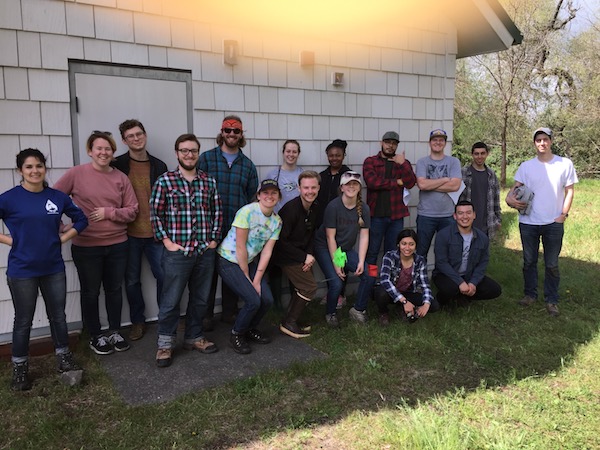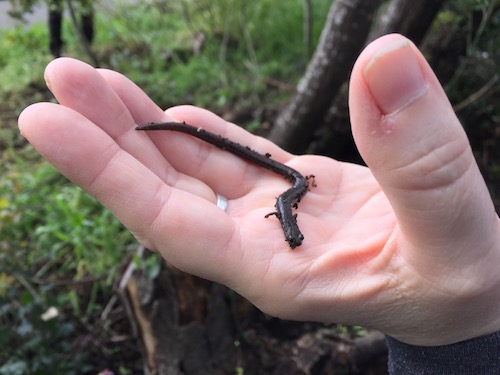For our first off-campus field trip of the semester, today I took my Field Biology class up Sonoma Mountain, to the Sonoma Mountain Ranch . . . a working cattle ranch about 30 minutes’ drive from campus. A wide variety of research is being conducted at the site, about the interaction between cattle and ecosystems, and also on the wildlife that uses the preserve. Today, our visit was hosted by Daniel Hudson, an SSU graduate student who is doing research on the various species of Pacific newts.
Before we left campus, the weather was looking a bit dodgy – overcast and chilly – and one of my students joked that it was probably snowing up on the mountain. We all laughed . . . of course, there was no WAY it would actually be snowing up there. Ha ha ha ha ahh hahahahahahahaha . . . .
Well, can you guess what the weather was like when we arrived at the top of the mountain?
No. It wasn’t snowing. Not really. I think “hailing” is a more accurate description.
Of course, this is a field biology class, and everyone knows that field biologists are not daunted by inclement weather (or biting insects, or venomous snakes, or bad road conditions, etc. etc.). So, we bundled up in as many layers as possible, and ventured out of our cars.
Daniel was there to meet us just inside the entrance gate, with a few little critters to start off the day: some lung-less slender salmanders (Batrachoseps attenuatus), and a Sierran Treefrog (Pseudacris regilla), who looked gravid (heavy with eggs).
We decided to have a quick look around near the entry gate, to see what we could find by flipping over some rocks and fallen branches. Spoiler alert: We found some really great stuff!

We really hit the motherlode when we turned over some abandoned railroad ties . . .
My personal favorite of the day . . . this GORGEOUS California newt (Taricha torosa):

Next, we visited one of the ranch’s stock ponds – a great place to dip net for newts! Daniel had already caught some rough-skinned newts (Taricha granulosa) earlier in the day, but we also had the opportunity to try and catch some ourselves!


One of my favorite moments of the day: Régine falling madly in love with the newts. (This is a feeling I know well . . . I so often fall madly in love with all sorts of gorgeous wild critters)!

We also found a few larvae (juvenile newts), an adorable tiny newt, and Daniel and Régine did some dip netting:
We headed a bit farther up the mountain, so Daniel could show us what he’s doing with his research. The weather had cleared up (look how GORGEOUS that sky was!), and we made some mammalian friends along the way. Some curious, and reasonably friendly, cows:

Near the research station, we were met by managing ecologist Jeff Wilcox, who taught the group how to do radio telemetry. Josh was the first one to give it a whirl:
We’d already had an amazing day, and we hadn’t even see Daniel’s research yet! But finally we made it to the location where he had his Y-maze set up – an apparatus he is using to test the newts’ ability to detect chemical cues that allow them to choose an appropriate mate. He’s also PIT-tagging them, so individual newts can be identified if they are recaptured later. (Daniel actually let me insert one of the PIT tags, and I know someone took pictures – I’ll add those to the post when I’m able to track them down).
Finally, it was time for us to call it a day, and head back down the mountain. We had SUCH a fantastic day, though, and many, many thanks to Daniel and Jeff for giving us such a wonderful experience at Sonoma Mountain Ranch. And we’ll be back . . . we have another trip planned near the end of the semester.
























































































 I can’t remember a time when I wasn’t fascinated and inspired by the natural world. Now, as an ecologist and science educator, I strive to inspire others with a similar love and appreciation for science.
I can’t remember a time when I wasn’t fascinated and inspired by the natural world. Now, as an ecologist and science educator, I strive to inspire others with a similar love and appreciation for science.
















